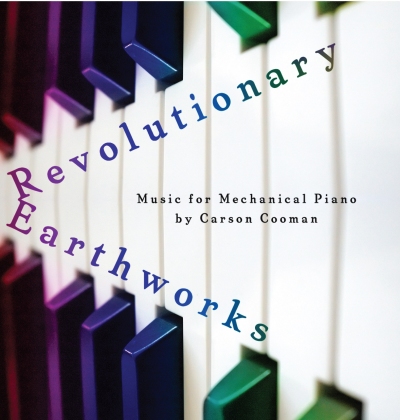If you have any questions about Zimbel Records offerings, please write to us at records@zimbel.com
Click here to return to recordings catalogue.

Revolutionary Earthworks: Music for Mechanical Piano by Carson
Cooman
Three Canons for Mechanical Piano (2009), The Better Part of Forever (2009) memory piece for mechanical piano, A Little Dance for Bill (2009) quasi-tango for mechanical piano, and Triadic Legends (2009) suite for mechanical piano
Price: $6
#ZR120
a Zimbel Records "CD Single"
duration: 31:10
Click below to purchase online!

====================
PROGRAM NOTES
The music on this album was specifically composed for mechanical piano. The "doyens" of this medium are Henry Cowell (who first proposed the idea of using a player piano to realize rhythms too complicated for accurate human reproduction), Conlon Nancarrow, James Tenney, and Kyle Gann. Nancarrow wrote his music for player pianos with rolls, but modern technology has made it possible for the music to be realized on computer-controlled pianos, such as the Yamaha Disklavier. Composing for mechanical piano allows unparalleled rhythmic potential, while still employing the beautiful and versatile timbre of the traditional acoustic piano.
Three Canons for Mechanical Piano (2009; op. 825) is dedicated to Thomas Brodhead. Each of the three movements employs canonic procedures and unfolds at a brisk tempo. In the first, A Watermelon Rondo, the melody circles back on itself frequently. In the second, Pleading the Fifth, both canonic voices are doubled at the interval of a fifth. In the third, Faster and Commander, the melody continuously gains in speed and momentum. A slow harmonic progression in the middle register builds force to the conclusion.
The Better Part of Forever (2009; op. 826), a memory piece for mechanical piano, is dedicated to Jan Swafford. The landscape of this work is colorful and resonant-bell-like melodies and harmonies unfold throughout. The rhythmic abilities of the mechanical piano are often employed to create a complex heterophony between contrapuntal melodic lines and their accompaniment. The piece is specifically inspired by and connected to the final lines of the poem The Long Boat by American poet Stanley Kunitz (1905-2006):
Peace! Peace!
To be rocked by the Infinite!
As if it didn't matter
which way was home;
as if he didn't know
he loved the earth so much
he wanted to stay forever.
A Little Dance for Bill (2009; op. 828), a quasi-tango for mechanical piano, is dedicated to William Bland. This work is a simple dance in E minor. The two melodic voices engage in heterophonic counterpoint over an ostinato in the bass. A series of bell-like chords briefly asserts itself, before the dance resumes.
Triadic Legends (2009; op. 824), a suite for mechanical piano, is dedicated to Kyle Gann. Each of the three movements uses basic triads as the principal material. Triads are employed for their raw sound, but also their ability to immediately conjure up "functional" progressions in the listener's ear. Each movement contains a repeating, steady layer that modulates throughout the movement.
The title of the first movement, Truest Horse, is taken from a simile in William Shakespeare's A Midsummer Night's Dream - "As true as truest horse that yet would never tire, I'll meet thee Pyramus at Ninny's tomb&ldots;." This simply-constructed movement takes its inspiration from the rather silly "play within a play" performed by Shakespeare's "rude mechanicals." The same ideas (without any development) are overlapped in different, schizophrenic ways. A driven 16th note pattern runs throughout, punctuated by triadic arpeggios that assert themselves (without tiring) in the treble register.
The Strangeness of Kindling explores melody and counterpoint with the kinds of idiosyncratic modality that have interested me in the past several years. However, due to the rhythmic capabilities of the mechanical piano, the melodies and counterpoint unfold primarily in a rhythmic relationship of 13:7:4:3. The movement begins with the substrate layer (the 3), consisting of a series of quasi-functional modal triads. These generate the modality of the upper lines, though they are often offset in time, creating the overall poly-modal sonority of the movement.
Revolutionary Earthworks takes its title from a historical association sign near my home noting the particular location of an earthworks used during the Revolutionary War. The title serves well to describe the surging character of this movement. Running throughout is a quiet, steady pattern of obliviously perky four-note triad-based chords. This layer pursues an independent tempo to the rest of the music (in a 5:4 relationship).
(Notes by Carson Cooman)